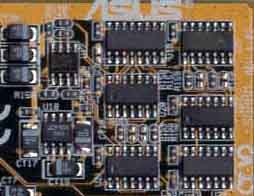The software bundle of the V3800 is stellar considering the fact that ASUS' main market isn't the graphics card industry. Full versions of Turok2 and XG2 are bundled with the card, as well as the card's Live3800 Video Capturing drivers. The drivers that ASUS shipped with the V3800 TVR seemed to be a slightly out of date version of the TNT2 drivers from NVIDIA with relatively poor support for Super7 platforms. Hopefully NVIDIA will release the next version of their TNT2 drivers shortly which will allow Super7 users to enjoy improved 3DNow! performance as well as a general performance increase across the board. Speaking of Super7, ASUS chose (wisely) to bundle the latest AGP GART drivers on their CD, for MVP3 users this means virtually guaranteed compatibility as v3.3 of the VIA GART drivers eliminate most problems with the TNT2 and the MVP3 chipset. Keep in mind that if you download the latest reference drivers from NVIDIA for use with your V3800, you lose ASUS' utilities until ASUS updates their drivers with the latest version of the NVIDIA drivers. It won't be a permanent loss, but keep in mind that it is a loss you'll have to live with for a short time.
ASUS also chose to include one of the most detailed and helpful user's manuals AnandTech has ever seen bundled with a graphics card, although the manual isn't perfect, it's better than what the competition is shipping with their cards (if anything at all).
| Once again breaking the tradition of Taiwanese motherboard manufacturers that enter into the graphics card industry, ASUS put much time and effort into the production of their V3800 drivers. The utility bundled with the V3800 is top notch, and almost as user friendly as Diamond’s praised InControl Tools 99. Not only does the bundled utility contain information about your board as well as other V3800 boards in the product line, it allows for the disabling of v-sync, as well as the overclocking of the card itself. From the manufacturer of the world’s first widely available motherboard with support for the 83MHz FSB frequency, would you expect any less? |
|
Final Words
ASUS’ combination of features and quality would definitely make the V3800 the board of choice if it wasn’t for one very important factor, cost. All of these features come at a cost to the user, and a cost that quite a few gamers don’t want to or can’t afford to pay. The ASUS V3800 TVR as reviewed here, with the TV-in/out and the VR-out, retails for $199.99. Keeping in mind that the 125/150 default clock of this board is considerably lower than the 175/183 default of the Guillemot Maxi Gamer, as well as the 175/200 of the Hercules Dynamite TNT2 Ultra which are both priced around the $199 - $229 mark, the V3800 doesn’t seem to be the most cost effective product on the market for the gamer on a budget. You do get what you pay for in this industry, but you need to make the decision, support for nerdy glasses (and a handful of other features) or blazing performance ;)











0 Comments
View All Comments